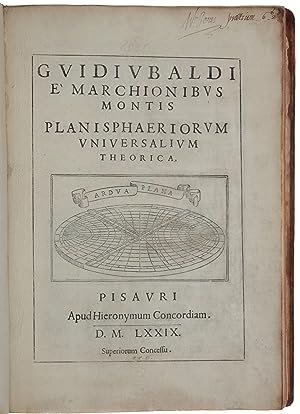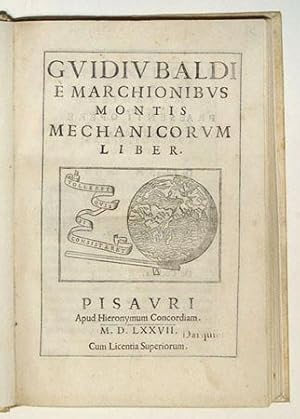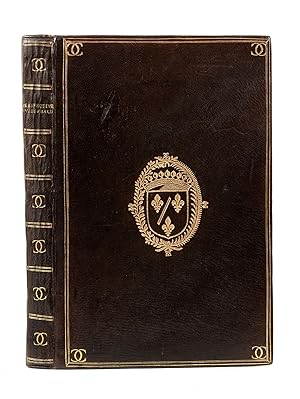monte guido ubaldo marchese (5 résultats)
Type d'article
- Tous les types d'articles
- Livres (5)
- Magazines & Périodiques
- Bandes dessinées
- Partitions de musique
- Art, Affiches et Gravures
- Photographies
- Cartes
-
Manuscrits &
Papiers anciens
Etat
Reliure
Particularités
- Edition originale (3)
- Signé (1)
- Jaquette
- Avec images
- Sans impression à la demande (3)
Livraison gratuite
Pays
Evaluation du vendeur
-
Gvidivbaldi e? marchionibvs Montis Perspectivae libri sex (1600) (Reprint) [Leatherbound]
Edité par Pranava Books, 2020
Vendeur : S N Books World, Delhi, Inde
Livre impression à la demande
Leatherbound. Etat : NEW. Leatherbound edition. Condition: New. Language: lat Leather Binding on Spine and Corners with Golden leaf printing on spine. Reprinted from BK edition. NO changes have been made to the original text. This is NOT a retyped or an ocr'd reprint. Illustrations, Index, if any, are included in black and white. Each page is checked manually before printing. As this print on demand book is reprinted from a very old book, there could be some missing or flawed pages, but we always try to make the book as complete as possible. Fold-outs, if any, are not part of the book. If the original book was published in multiple volumes then this reprint is of only one volume, not the whole set. IF YOU WISH TO ORDER PARTICULAR VOLUME OR ALL THE VOLUMES YOU CAN CONTACT US. Sewing binding for longer life, where the book block is actually sewn (smythe sewn/section sewn) with thread before binding which results in a more durable type of binding. THERE MIGHT BE DELAY THAN THE ESTIMATED DELIVERY DATE DUE TO COVID-19. Pages: 324 Pages: 324.
-
Gvidivbaldi è marchionibvs Montis Perspectivae libri sex [LeatherBound]
Date d'édition : 2023
Vendeur : True World of Books, Delhi, Inde
Livre impression à la demande
LeatherBound. Etat : New. LeatherBound edition. Condition: New. Reprinted from 1600 edition. Leather Binding on Spine and Corners with Golden leaf printing on spine. Bound in genuine leather with Satin ribbon page markers and Spine with raised gilt bands. A perfect gift for your loved ones. NO changes have been made to the original text. This is NOT a retyped or an ocr'd reprint. Illustrations, Index, if any, are included in black and white. Each page is checked manually before printing. As this print on demand book is reprinted from a very old book, there could be some missing or flawed pages, but we always try to make the book as complete as possible. Fold-outs, if any, are not part of the book. If the original book was published in multiple volumes then this reprint is of only one volume, not the whole set. Sewing binding for longer life, where the book block is actually sewn (smythe sewn/section sewn) with thread before binding which results in a more durable type of binding. Pages: 328 Language: Latin.
-
Planisphaeriorum universalium theorica
Edité par Girolamo Concordia, Pesaro, 1579
Vendeur : SOPHIA RARE BOOKS, Koebenhavn V, Danemark
Membre d'association : ILAB
Edition originale Signé
First edition. THEORY OF THE PLANISPHERE - THE JONES-MACCLESFIELD COPY . First edition, very rare, the Jones-Macclesfield copy, signed by William Jones, of the first modern theoretical treatise on the planisphere, an instrument for representing the celestial sphere on a plane surface. Guidobaldo was one of the most prominent figures in the renaissance of the mathematical sciences, and is famous for his Mechanicorum liber (1577), generally regarded as the most important treatise on mechanics since Archimedes and a critical influence on his friend and disciple Galileo. "Two years after the publication of the Mechanicorum Liber, Guidobaldo released the Planisphaeriorum Universalium Theorica (1579), re-edited after another two years later at Cologne. The treatise attended to the mathematical branch in which Guidobaldo seems to have been most interested besides mechanics, namely to perspective . Guidobaldo's treatise of 1579 is subdivided in two books and is dedicated to the explication of various types of planispheres. Planispheres had the function to represent in the plane the celestial sphere with all his significant circles - a procedure that obviously posed problems relative to stereographic or orthogonal projection, according to the type of planisphere. Fundamental for their construction were the empirical guidelines given in Ptolemy's Planisphaerium. A different way of stereographic projection had been found by Gemma Frisius (1508-55), exposed in De astrolabio catholico (1556), by assuming the centre of projection on the equinoctial circle, while in Ptolemy it was fixed in one of the two poles. The advantage of this method consisted in the possibility to adapt the planisphere to an arbitrary latitude (for that reason it was called 'universal'), while Ptolemy's was valid only for a specific horizon.In the first book, Guidobaldo attends to comment on Gemma Frisius's planisphere furnishing geometrical demonstrations of what had remained unproven by the Dutch mathematician. Furthermore, he gave the necessary indications to construct the described device. In the second book, Guidobaldo approached the analysis of the planisphere of Juan De Rojas, considered the inventor of the universal astrolabe. As the projection exposed by the Spanish mathematician refers to a point of observation at infinite distance, his planisphere poses problems relative to orthographic projection. Guidobaldo addressed himself to the topic with the usual mathematical rigour, inter alia proving that the section of a cylinder and a plane (not parallel to the axis of the cylinder) is generally an ellipse - a fact unknown both to De Rojas and to Frisius. Here, again, he exposed a scientific instrument appropriate to draw ellipses, with a clear and detailed theoretical justification. This fact confirms Guidobaldo's interest in the practical aspects connected with mathematics, besides his unquestioned skill to present theorisations of mathematical fields" (Frank, pp. 40-41). ABPC/RBH lists only one other complete copy in a contemporary binding in the last 40 years. Provenance: William Jones (1675-1749) (signature on title), probably acquired by him from John Collins (1626-83); the Earls of Macclesfield (South Library bookplate on front paste-down, embossed stamp on first two leaves); sold Sotheby's, 13 April 2005, lot 1434, £3,360 ($6,372). As the Macclesfield catalogue notes (A-C, p. 12), "It is not unreasonable to suppose that anything published before 1683 [in the Macclesfield library] belonged to him [i.e., Collins]". It would seem very likely that Collins would have owned a copy of this book, given his own interest in mathematical instruments - he wrote The sector on a quadrant (1658); Geometrical dyalling (1659); and The mariner's plain scale (1659). Jones acquired Collins's books and papers some time before he edited Newton's Analysis per quantitatum series (1711). "Painters were well acquainted with the representation of a three-dimensional object by three two-dimensional drawings, in each of which the object is viewed along parallel lines that are perpendicular to the plane of the drawing (plan, front and side elevations). For example, a projection by means of parallel lines was used by Albrecht Dürer in his Von Menschlicher Proportion in 1528. Dürer used an orthographic projection to foreshorten the heads of humans, showing a top, front and side view, a method already used by Piero della Francesca in his unpublished manuscript De Prospectiva Pingendi. Thus, as a drawing method, a projection along parallel lines must have been common practice in the painter's workshop. However, it was left to the designers of mathematical instruments around the middle of the sixteenth century to understand the orthographic projection as a projection along parallel lines perpendicular to the plane of projection with the center of projection at infinity. "Astrolabes had a plate showing a map of the celestial sphere. The equator, the tropics, the ecliptic, the lines of equal azimuth and the almucantars were projected onto the astrolabe plate. Most common, also in the sixteenth century, was the use of a stereographic projection, with the south celestial pole as center of projection and the plane of the equator (or a plane parallel to it) as the plane of projection. This type of stereographic projection was used by Stöffler in his Elucidatio fabricae ususque astrolabii (1513). "However, a major drawback was that the astrolabe plate made with this type of stereographic projection could only be used at the particular latitude it was designed for - each latitude asked for a different plate. The sixteenth century saw the publication of two different types of projection that were considered to be a solution to this problem. These projections allowed a 'universal' application of the astrolabe, that is, only one plate was needed, whatever the latitude of the observer or user of the astrolabe. "In 1556, the 'astrolabum catholicum' of Gemma Frisius was posthum.
-
Mechanicorum Liber.
Edité par Pesaro H. Concordia 1577., 1577
Vendeur : Martayan Lan, New York, NY, Etats-Unis
Edition originale
Folio [29.4 x 19.6 cm], (8) ff. (the last blank), 130, (1) f. [colophon], 1 integral blank, with numerous woodcut diagrams and illustrations in text. Old ownership stamp "Darquier" neatly stenciled on title (the Toulousain astronomer Antoine Darquier de Pellepoix 1718-1802?) Bound in 18th century vellum over paste boards, covers a bit soiled and abraded. Inconsequential soiling and a little spotting to title; even toning to some quires, but generally a fresh and appealing copy. Rare first edition of the author s first work, generally regarded as the most important treatise on mechanics since Archimedes and a critical influence on Galileo. The work is notable for its commitment to establishing mechanics on a rigorously mathematical basis, for its powerful argument that mechanics and statics are separate sciences and for its insistence that mechanics should not consider abstract and/or abstruse entities but the activity of machines. Stillman Drake particularly emphasizes the importance of the section on pulleys, where Monte reduces them (as he does most other simple machines) to a lever. As such, the work has technological implications for navigation, manufacture, the plastic arts and medicine (f. 245)."From the time of its publication in 1577. [it was] the most authoritative treatise on statics to emerge since antiquity, and it remained pre-eminent until the appearance of Galileo s Two New Sciences in 1638. It marks the high point of the Archimedean revival of the Renaissance" (Rose, Italian Renaissance of Mathematics, p. 222).Monte (1545-1607) studied mathematics at Padua and subsequently at Urbino, where he studied with Commandino, editing and publishing the latter s translation of Pappus. He conducted an extensive scientific correspondence with Galileo, securing for the Florentine his chairs at Pisa and later at Padua.* Adams U-7; Riccardi II.178; P.L. Rose, DSB IX.487-89, & The Italian Renaissance of Mathematics, pp. 222ff.; Biblioteca Mechanica, pp. 228-9.
-
Perspectivae Libri Sex
Vendeur : Jonathan A. Hill, Bookseller Inc., New York, NY, Etats-Unis
Edition originale
Large woodcut diagram on title & more than 300 woodcut diagrams in the text. 2 p.l., 310, [1] pp. Small folio, cont. dark green morocco, arms of Charles de Valois on sides & his monogram in corners (Olivier 2600, fers 6 & 7), triple gilt fillet round sides, flat spine divided into seven compartments, six with monogram repeated, a.e.g. Pesaro: G. Concordia, 1600. First edition of this important landmark in the history of the science of perspective and a precious copy from the library of Charles of Valois (1573-1650), finely bound in contemporary green morocco with his arms. Charles was the natural son of Charles IX and was also Count, then Duke of Angouléme. He served in numerous military campaigns and was imprisoned for a number of years for having taken part in several intrigues. Released in 1616, he was appointed ambassador to Germany in 1620. His considerable collection of books was left by his elder son, Louis de Valois, Comte d'Alais, to the Minims of La Guiche in Charolais. Its library was dispersed at the time of the French Revolution. Monte (1545-1607), was Galileo's patron and friend for 20 years and was possibly the greatest single influence on the mechanics of Galileo. This work "is the culminating book in the phase of mathematical perspective with which we have been concerned.His Perspectivae libri sex provided a definitive and often original analysis of the mathematics of perspectival projection, in a far more extended way than either Commandino or Benedetti had aimed to do.Guidobaldo's book rightly came to be regarded as the main source of reference for anyone seriously interested in the underlying geometry of perspectival projection. But this is not to say that he made life at all easy for the painter who wishes to approach his text. His only substantial treatment of a representational technique occurred in his final book, in which he analysed the scenographic perspective of stage design."-Kemp, The Science of Art, pp. 89-91-(& see his detailed account of the contents of the book). Galileo apparently read the work in manuscript in 1594, and the illustrations of shadows on the lunar surface in his Sidereus Nuncius (1610) may be based on Book 5 (see S.Y. Edgerton in Art Journal 44, Fall 1984, p. 226). A magnificent copy preserved in a morocco-backed box; 17th-century ownership inscription on title, "Ex Bibliotheca Minimorum Guichiensium." â § Besterman, Old Art Books, p. 74. D.S.B., IX, p. 487-89. Riccardi, II, 179.


![Image du vendeur pour Gvidivbaldi e? marchionibvs Montis Perspectivae libri sex (1600) (Reprint) [Leatherbound] mis en vente par S N Books World](https://pictures.abebooks.com/inventory/md/md30638269760.jpg)
![Image du vendeur pour Gvidivbaldi è marchionibvs Montis Perspectivae libri sex [LeatherBound] mis en vente par True World of Books](https://pictures.abebooks.com/inventory/md/md31533313468.jpg)


